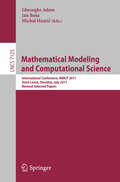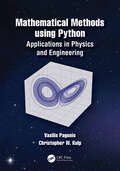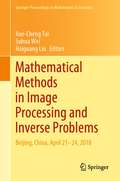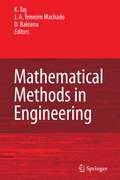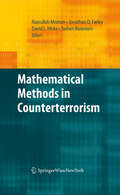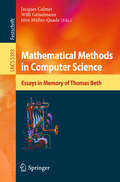- Table View
- List View
Mathematical Modeling for Genes to Collective Cell Dynamics (Theoretical Biology)
by Tetsuji TokihiroThis book describes the dynamics of biological cells and their mathematical modeling. The topics cover the dynamics of RNA polymerases in transcription, construction of vascular networks in angiogenesis, and synchronization of cardiomyocytes. Statistical analysis of single cell dynamics and classification of proteins by mathematical modeling are also presented. The book provides the most up-to-date information on both experimental results and mathematical models that can be used to analyze cellular dynamics. Novel experimental results and approaches to understand them will be appealing to the readers. Each chapter contains 1) an introductory description of the phenomenon, 2) explanations about the mathematical technique to analyze it, 3) new experimental results, 4) mathematical modeling and its application to the phenomenon. Elementary introductions for the biological phenomenon and mathematical approach to them are especially useful for beginners. The importance of collaboration between mathematics and biological sciences has been increasing and providing new outcomes. This book gives good examples of the fruitful collaboration between mathematics and biological sciences.
Mathematical Modeling for Complex Fluids and Flows
by Michel Deville Thomas B. GatskiMathematical Modeling for Complex Fluids and Flows provides researchers and engineering practitioners encountering fluid flows with state-of-the-art knowledge in continuum concepts and associated fluid dynamics. In doing so it supplies the means to design mathematical models of these flows that adequately express the engineering physics involved. It exploits the implicit link between the turbulent flow of classical Newtonian fluids and the laminar and turbulent flow of non-Newtonian fluids such as those required in food processing and polymeric flows.The book develops a descriptive mathematical model articulated through continuum mechanics concepts for these non-Newtonian, viscoelastic fluids and turbulent flows. Each complex fluid and flow is examined in this continuum context as well as in combination with the turbulent flow of viscoelastic fluids. Some details are also explored via kinetic theory, especially viscoelastic fluids and their treatment with the Boltzmann equation. Both solution and modeling strategies for turbulent flows are laid out using continuum concepts, including a description of constructing polynomial representations and accounting for non-inertial and curvature effects.Ranging from fundamental concepts to practical methodology, and including discussion of emerging technologies, this book is ideal for those requiring a single-source assessment of current practice in this intricate yet vital field.
Mathematical Modeling, Computational Intelligence Techniques and Renewable Energy: Proceedings of the Third International Conference, MMCITRE 2022 (Advances in Intelligent Systems and Computing #1440)
by Manoj Sahni José M. Merigó Walayat Hussain Ernesto León-Castro Raj Kumar Verma Ritu SahniThe book is a collection of best selected research papers presented at the Third International Conference on “Mathematical Modeling, Computational Intelligence Techniques and Renewable Energy (MMCITRE 2022),” organized by the University of Technology Sydney, Australia, in association with the Department of Mathematics, Pandit Deendayal Energy University, India, and Forum for Interdisciplinary Mathematics. This book presents new knowledge and recent developments in all aspects of computational techniques, mathematical modeling, energy systems, applications of fuzzy sets and intelligent computing. The book provides innovative works of researchers, academicians and students in the area of interdisciplinary mathematics, statistics, computational intelligence and renewable energy.
Mathematical Modeling, Computational Intelligence Techniques and Renewable Energy: Proceedings of the First International Conference, MMCITRE 2020 (Advances in Intelligent Systems and Computing #1287)
by Manoj Sahni José M. Merigó Brajesh Kumar Jha Rajkumar VermaThis book presents new knowledge and recent developments in all aspects of computational techniques, mathematical modeling, energy systems, applications of fuzzy sets and intelligent computing. The book is a collection of best selected research papers presented at the International Conference on “Mathematical Modeling, Computational Intelligence Techniques and Renewable Energy,” organized by the Department of Mathematics, Pandit Deendayal Petroleum University, in association with Forum for Interdisciplinary Mathematics, Institution of Engineers (IEI) – Gujarat and Computer Society of India (CSI) – Ahmedabad. The book provides innovative works of researchers, academicians and students in the area of interdisciplinary mathematics, statistics, computational intelligence and renewable energy.
Mathematical Modeling, Computational Intelligence Techniques and Renewable Energy: Proceedings of the Second International Conference, MMCITRE 2021 (Advances in Intelligent Systems and Computing #1405)
by Manoj Sahni José M. Merigó Ritu Sahni Rajkumar VermaThis book presents new knowledge and recent developments in all aspects of computational techniques, mathematical modeling, energy systems, and applications of fuzzy sets and intelligent computing. The book is a collection of best selected research papers presented at the Second International Conference on “Mathematical Modeling, Computational Intelligence Techniques and Renewable Energy (MMCITRE 2021),” organized by the Department of Mathematics, Pandit Deendayal Petroleum University, in association with Forum for Interdisciplinary Mathematics. The book provides innovative works of researchers, academicians, and students in the area of interdisciplinary mathematics, statistics, computational intelligence, and renewable energy.
Mathematical Modeling and Supercomputer Technologies: 20th International Conference, MMST 2020, Nizhny Novgorod, Russia, November 23 – 27, 2020, Revised Selected Papers (Communications in Computer and Information Science #1413)
by Dmitry Balandin Konstantin Barkalov Victor Gergel Iosif MeyerovThis book constitutes selected and revised papers from the 20th International Conference on Mathematical Modeling and Supercomputer Technologies, MMST 2020, held in Nizhny Novgorod, Russia, in November 2020. Due to the COVID-19 pandemic the conference was held online. The 25 full papers and 8 short papers presented in the volume were thoroughly reviewed and selected from the 106 submissions. They are organized in topical secions on computational methods for mathematical models analysis; computation in optimization and optimal control; supercomputer simulation.
Mathematical Modeling and Supercomputer Technologies: 22nd International Conference, MMST 2022, Nizhny Novgorod, Russia, November 14–17, 2022, Revised Selected Papers (Communications in Computer and Information Science #1750)
by Dmitry Balandin Konstantin Barkalov Iosif MeyerovThis book constitutes selected and revised papers from the 22nd International Conference on Mathematical Modeling and Supercomputer Technologies, MMST 2022, held in Nizhny Novgorod, Russia, in November 2022. The 20 full papers and 5 short papers presented in the volume were thoroughly reviewed and selected from the 48 submissions. They are organized in topical secions on computational methods for mathematical models analysis; computation in optimization and optimal control; supercomputer simulation.
Mathematical Modeling and Supercomputer Technologies: 23rd International Conference, MMST 2023, Nizhny Novgorod, Russia, November 13–16, 2023, Revised Selected Papers (Communications in Computer and Information Science #1914)
by Dmitry Balandin Konstantin Barkalov Iosif MeyerovThis book constitutes selected and revised papers from the 23rd International Conference on Mathematical Modeling and Supercomputer Technologies, MMST 2023, held in Nizhny Novgorod, Russia, during November 13–16 2023. The 18 full papers and 7 short papers presented in the volume were thoroughly reviewed and selected from the 45 submissions. They are organized in topical sections as follows: computational methods for mathematical models analysis; computation in optimization and optimal control; artificial intelligence and supercomputer simulation.
Mathematical Modeling and Simulation of Systems: Selected Papers of 14th International Scientific-Practical Conference, MODS, 2019 June 24-26, Chernihiv, Ukraine (Advances in Intelligent Systems and Computing #1019)
by Alexander Palagin Anatoliy Anisimov Anatoliy Morozov Serhiy ShkarletThis book presents current investigations in the field of mathematical modeling and simulation to support the development of intelligent information systems in domains such as ecology and geology, manufacturing, project management, and safety of distributed information systems. The book will be of interest to developers of modern high-tech software complexes for situational control centers, based on mathematical modeling and simulation methods. In addition, it will appeal to software engineers and programmers, offering them new implementation and application methods. Gathering the latest research, prepared by leading scholars, and identifying promising new directions for solving complex scientific and practical problems, the book presents selected outcomes of the 14th International Scientific-Practical Conference, MODS2019, held in Chernihiv, Ukraine, on June 24 to 26, 2019.
Mathematical Modeling and Simulation of Systems: Selected Papers of 15th International Scientific-practical Conference, MODS, 2020 June 29 – July 01, Chernihiv, Ukraine (Advances in Intelligent Systems and Computing #1265)
by Serhiy Shkarlet Anatoliy Morozov Alexander PalaginThis book contains works on mathematical and simulation modeling of processes in various domains: ecology and geographic information systems, IT, industry, and project management. The development of complex multicomponent systems requires an increase in accuracy, efficiency, and adequacy while reducing the cost of their creation.The studies presented in the book are useful to specialists who are involved in the development of real events models: analog, management and decision-making models, production models, and software products. Scientists can get acquainted with the latest research in various decisions proposed by leading scholars and identify promising directions for solving complex scientific and practical problems. The chapters of this book contain the contributions presented on the 15th International Scientific-Practical Conference, MODS, June 29–July 01, 2020, Chernihiv, Ukraine.
Mathematical Modeling and Signal Processing in Speech and Hearing Sciences (MS&A #10)
by Jack Xin Yingyong QiThe aim of the book is to give an accessible introduction of mathematical models and signal processing methods in speech and hearing sciences for senior undergraduate and beginning graduate students with basic knowledge of linear algebra, differential equations, numerical analysis, and probability. Speech and hearing sciences are fundamental to numerous technological advances of the digital world in the past decade, from music compression in MP3 to digital hearing aids, from network based voice enabled services to speech interaction with mobile phones. Mathematics and computation are intimately related to these leaps and bounds. On the other hand, speech and hearing are strongly interdisciplinary areas where dissimilar scientific and engineering publications and approaches often coexist and make it difficult for newcomers to enter.
Mathematical Modeling and Optimization of Complex Structures (Computational Methods in Applied Sciences #40)
by Pekka Neittaanmäki Sergey Repin Tero TuovinenThis volume contains selected papers in three closely related areas: mathematical modeling in mechanics, numerical analysis, and optimization methods. The papers are based upon talks presented on the International Conference for Mathematical Modeling and Optimization in Mechanics, held in Jyväskylä, Finland, March 6-7, 2014 dedicated to Prof. N. Banichuk on the occasion of his 70th birthday. The articles are written by well-known scientists working in computational mechanics and in optimization of complicated technical models. Also, the volume contains papers discussing the historical development, the state of the art, new ideas, and open problems arising in modern continuum mechanics and applied optimization problems. Several papers are concerned with mathematical problems in numerical analysis, which are also closely related to important mechanical models. The main topics treated include: * Computer simulation methods in mechanics, physics, and biology;* Variational problems and methods; minimization algorithms;* Optimal control problems with distributed and discrete control;* Shape optimization and shape design problems in science and engineering;* Sensitivity analysis and parameters optimization of complex systems.
Mathematical Modeling and Numerical Simulation in Continuum Mechanics: Proceedings of the International Symposium on Mathematical Modeling and Numerical Simulation in Continuum Mechanics, September 29 – October 3, 2000 Yamaguchi, Japan (Lecture Notes in Computational Science and Engineering #19)
by Ivo Babuska Philippe G. Ciarlet Tetsuhiko MiyoshiThe first international symposium on mathematical foundations of the finite element method was held at the University of Maryland in 1973. During the last three decades there has been great progress in the theory and practice of solving partial differential equations, and research has extended in various directions. Full-scale nonlinear problems have come within the range of nu merical simulation. The importance of mathematical modeling and analysis in science and engineering is steadily increasing. In addition, new possibili ties of analysing the reliability of computations have appeared. Many other developments have occurred: these are only the most noteworthy. This book is the record of the proceedings of the International Sympo sium on Mathematical Modeling and Numerical Simulation in Continuum Mechanics, held in Yamaguchi, Japan from 29 September to 3 October 2000. The topics covered by the symposium ranged from solids to fluids, and in cluded both mathematical and computational analysis of phenomena and algorithms. Twenty-one invited talks were delivered at the symposium. This volume includes almost all of them, and expresses aspects of the progress mentioned above. All the papers were individually refereed. We hope that this volume will be a stepping-stone for further developments in this field.
Mathematical Modeling and Computational Science: International Conference, MMCP 2011, Stará Lesná, Slovakia, July 4-8, 2011, Revised Selected Papers (Lecture Notes in Computer Science #7125)
by Gheorghe Adam Ján Busa Michal Hnati 269This book constitutes the refereed post-proceedings of the International Conference on Mathematical Modeling and Computational Physics, MMCP 2011, held in Stará Lesná, Slovakia, in July 2011. The 41 revised papers presented were carefully reviewed and selected from numerous submissions. They are organized in topical sections on mathematical modeling and methods, numerical modeling and methods, computational support of the experiments, computing tools, and optimization and simulation.
Mathematical Modeling and Computational Intelligence in Engineering Applications
by Antônio José da Silva Neto Orestes Llanes Santiago Geraldo Nunes SilvaThis book brings together a rich selection of studies in mathematical modeling and computational intelligence, with application in several fields of engineering, like automation, biomedical, chemical, civil, electrical, electronic, geophysical and mechanical engineering, on a multidisciplinary approach. Authors from five countries and 16 different research centers contribute with their expertise in both the fundamentals and real problems applications based upon their strong background on modeling and computational intelligence. The reader will find a wide variety of applications, mathematical and computational tools and original results, all presented with rigorous mathematical procedures. This work is intended for use in graduate courses of engineering, applied mathematics and applied computation where tools as mathematical and computational modeling, numerical methods and computational intelligence are applied to the solution of real problems.
Mathematical Modeling: Problems, Methods, Applications
by Ludmilla A. Uvarova Anatolii V. LatyshevThis volume contains review articles and original results obtained in various fields of modern science using mathematical simulation methods. The basis of the articles are the plenary and some section reports that were made and discussed at the Fourth International Mathematical Simulation Conference, held in Moscow on June 27 through July 1, 2000. The conference was devoted to the following scientific areas: • mathematical and computer discrete systems models; • non-linear excitation in condensed media; • complex systems evolution; • mathematical models in economics; • non-equilibrium processes kinematics; • dynamics and structure of the molecular and biomolecular systems; • mathematical transfer models in non-linear systems; • numerical simulation and algorithms; • turbulence and determined chaos; • chemical physics of polymer. This conference was supported by the Russian Ministry of Education, Russian foundation for Basic Research and Federal Program "Integration". This volume contains the following sections: 1. models of non-linear phenomena in physics; 2. numerical methods and computer simulations; 3. mathematical computer models of discrete systems; 4. mathematical models in economics; 5. non-linear models in chemical physics and physical chemistry; 6. mathematical models of transport processes in complex systems. In Sections One and Five a number of fundamental and sufficiently general problems, concerning real physical and physical-chemical systems simulation, is discussed.
Mathematical Methods using Python: Applications in Physics and Engineering
by Vasilis Pagonis Christopher Wayne KulpThis advanced undergraduate textbook presents a new approach to teaching mathematical methods for scientists and engineers. It provides a practical, pedagogical introduction to utilizing Python in Mathematical and Computational Methods courses. Both analytical and computational examples are integrated from its start. Each chapter concludes with a set of problems designed to help students hone their skills in mathematical techniques, computer programming, and numerical analysis. The book places less emphasis on mathematical proofs, and more emphasis on how to use computers for both symbolic and numerical calculations. It contains 182 extensively documented coding examples, based on topics that students will encounter in their advanced courses in Mechanics, Electronics, Optics, Electromagnetism, Quantum Mechanics etc.An introductory chapter gives students a crash course in Python programming and the most often used libraries (SymPy, NumPy, SciPy, Matplotlib). This is followed by chapters dedicated to differentiation, integration, vectors and multiple integration techniques. The next group of chapters covers complex numbers, matrices, vector analysis and vector spaces. Extensive chapters cover ordinary and partial differential equations, followed by chapters on nonlinear systems and on the analysis of experimental data using linear and nonlinear regression techniques, Fourier transforms, binomial and Gaussian distributions. The book is accompanied by a dedicated GitHub website, which contains all codes from the book in the form of ready to run Jupyter notebooks. A detailed solutions manual is also available for instructors using the textbook in their courses.Key Features:· A unique teaching approach which merges mathematical methods and the Python programming skills which physicists and engineering students need in their courses.· Uses examples and models from physical and engineering systems, to motivate the mathematics being taught.· Students learn to solve scientific problems in three different ways: traditional pen-and-paper methods, using scientific numerical techniques with NumPy and SciPy, and using Symbolic Python (SymPy).Vasilis Pagonis is Professor of Physics Emeritus at McDaniel College, Maryland, USA. His research area is applications of thermally and optically stimulated luminescence. He taught courses in mathematical physics, classical and quantum mechanics, analog and digital electronics and numerous general science courses. Dr. Pagonis’ resume lists more than 200 peer-reviewed publications in international journals. He is currently associate editor of the journal Radiation Measurements. He is co-author with Christopher Kulp of the undergraduate textbook “Classical Mechanics: a computational approach, with examples in Python and Mathematica” (CRC Press, 2020). He has also co-authored four graduate-level textbooks in the field of luminescence dosimetry, and most recently published the book “Luminescence Signal analysis using Python” (Springer, 2022).Christopher Kulp is the John P. Graham Teaching Professor of Physics at Lycoming College. He has been teaching undergraduate physics at all levels for 20 years. Dr. Kulp’s research focuses on modelling complex systems, time series analysis, and machine learning. He has published 30 peer-reviewed papers in international journals, many of which include student co-authors. He is also co-author of the undergraduate textbook “Classical Mechanics: a computational approach, with examples in Python and Mathematica” (CRC Press, 2020).
Mathematical Methods using Python: Applications in Physics and Engineering
by Vasilis Pagonis Christopher Wayne KulpThis advanced undergraduate textbook presents a new approach to teaching mathematical methods for scientists and engineers. It provides a practical, pedagogical introduction to utilizing Python in Mathematical and Computational Methods courses. Both analytical and computational examples are integrated from its start. Each chapter concludes with a set of problems designed to help students hone their skills in mathematical techniques, computer programming, and numerical analysis. The book places less emphasis on mathematical proofs, and more emphasis on how to use computers for both symbolic and numerical calculations. It contains 182 extensively documented coding examples, based on topics that students will encounter in their advanced courses in Mechanics, Electronics, Optics, Electromagnetism, Quantum Mechanics etc.An introductory chapter gives students a crash course in Python programming and the most often used libraries (SymPy, NumPy, SciPy, Matplotlib). This is followed by chapters dedicated to differentiation, integration, vectors and multiple integration techniques. The next group of chapters covers complex numbers, matrices, vector analysis and vector spaces. Extensive chapters cover ordinary and partial differential equations, followed by chapters on nonlinear systems and on the analysis of experimental data using linear and nonlinear regression techniques, Fourier transforms, binomial and Gaussian distributions. The book is accompanied by a dedicated GitHub website, which contains all codes from the book in the form of ready to run Jupyter notebooks. A detailed solutions manual is also available for instructors using the textbook in their courses.Key Features:· A unique teaching approach which merges mathematical methods and the Python programming skills which physicists and engineering students need in their courses.· Uses examples and models from physical and engineering systems, to motivate the mathematics being taught.· Students learn to solve scientific problems in three different ways: traditional pen-and-paper methods, using scientific numerical techniques with NumPy and SciPy, and using Symbolic Python (SymPy).Vasilis Pagonis is Professor of Physics Emeritus at McDaniel College, Maryland, USA. His research area is applications of thermally and optically stimulated luminescence. He taught courses in mathematical physics, classical and quantum mechanics, analog and digital electronics and numerous general science courses. Dr. Pagonis’ resume lists more than 200 peer-reviewed publications in international journals. He is currently associate editor of the journal Radiation Measurements. He is co-author with Christopher Kulp of the undergraduate textbook “Classical Mechanics: a computational approach, with examples in Python and Mathematica” (CRC Press, 2020). He has also co-authored four graduate-level textbooks in the field of luminescence dosimetry, and most recently published the book “Luminescence Signal analysis using Python” (Springer, 2022).Christopher Kulp is the John P. Graham Teaching Professor of Physics at Lycoming College. He has been teaching undergraduate physics at all levels for 20 years. Dr. Kulp’s research focuses on modelling complex systems, time series analysis, and machine learning. He has published 30 peer-reviewed papers in international journals, many of which include student co-authors. He is also co-author of the undergraduate textbook “Classical Mechanics: a computational approach, with examples in Python and Mathematica” (CRC Press, 2020).
Mathematical Methods in Time Series Analysis and Digital Image Processing (Understanding Complex Systems)
by Rainer Dahlhaus Jürgen Kurths Peter Maass Jens TimmerThis coherent and articulate volume summarizes work carried out in the field of theoretical signal and image processing. It focuses on non-linear and non-parametric models for time series as well as on adaptive methods in image processing. The aim of this volume is to bring together research directions in theoretical signal and imaging processing developed rather independently in electrical engineering, theoretical physics, mathematics and the computer sciences.
Mathematical Methods in Program Development (NATO ASI Subseries F: #158)
by Manfred Broy Birgit SchiederModern information processing systems show such complex properties as distribution, parallelism, interaction, time dependency, and nondeterminism. For critical applications, mathematical methods are needed to model the systems and to support their development and validation. Impressive progress in mathematical methods for programming software systems makes it possible to think about unifying the different approaches. This book gives a comprehensive overview of existing methods and presents some of the most recent results in applying them. The main topics are: advanced programming techniques, foundations of systems engineering, mathematical support methods, and application of the methods. The approaches presented are illustrated by examples and related to other approaches.
Mathematical Methods in Image Processing and Inverse Problems: IPIP 2018, Beijing, China, April 21–24 (Springer Proceedings in Mathematics & Statistics #360)
by Xue-Cheng Tai Suhua Wei Haiguang LiuThis book contains eleven original and survey scientific research articles arose from presentations given by invited speakers at International Workshop on Image Processing and Inverse Problems, held in Beijing Computational Science Research Center, Beijing, China, April 21–24, 2018. The book was dedicated to Professor Raymond Chan on the occasion of his 60th birthday.The contents of the book cover topics including image reconstruction, image segmentation, image registration, inverse problems and so on. Deep learning, PDE, statistical theory based research methods and techniques were discussed. The state-of-the-art developments on mathematical analysis, advanced modeling, efficient algorithm and applications were presented. The collected papers in this book also give new research trends in deep learning and optimization for imaging science. It should be a good reference for researchers working on related problems, as well as for researchers working on computer vision and visualization, inverse problems, image processing and medical imaging.
Mathematical Methods in Engineering
by Nuno Miguel Fonseca Ferreira José António Tenreiro MachadoThis book presents a careful selection of the contributions presented at the Mathematical Methods in Engineering (MME10) International Symposium, held at the Polytechnic Institute of Coimbra- Engineering Institute of Coimbra (IPC/ISEC), Portugal, October 21-24, 2010.The volume discusses recent developments about theoretical and applied mathematics toward the solution of engineering problems, thus covering a wide range of topics, such as: Automatic Control, Autonomous Systems, Computer Science, Dynamical Systems and Control, Electronics, Finance and Economics, Fluid Mechanics and Heat Transfer, Fractional Mathematics, Fractional Transforms and Their Applications, Fuzzy Sets and Systems, Image and Signal Analysis, Image Processing, Mechanics, Mechatronics, Motor Control and Human Movement Analysis, Nonlinear Dynamics, Partial Differential Equations, Robotics, Acoustics, Vibration and Control, and Wavelets.
Mathematical Methods in Engineering
by K. Tas D. Baleanu J. A. Tenreiro MachadoThis book contains some of the contributions that have been carefully selected and peer-reviewed, which were presented at the International Symposium MME06 Mathematical Methods in Engineering, held in Cankaya University, Ankara, April 2006. The Symposium provided a setting for discussing recent developments in Fractional Mathematics, Neutrices and Generalized Functions, Boundary Value Problems, Applications of Wavelets, Dynamical Systems and Control Theory.
Mathematical Methods in Counterterrorism
by Nasrullah Memon Jonathan David Farley David L. Hicks Torben RosenornTerrorism is one of the serious threats to international peace and security that we face in this decade. No nation can consider itself immune from the dangers it poses, and no society can remain disengaged from the efforts to combat it. The termcounterterrorism refers to the techniques, strategies, and tactics used in the ?ght against terrorism. Counterterrorism efforts involve many segments of so- ety, especially governmental agencies including the police, military, and intelligence agencies (both domestic and international). The goal of counterterrorism efforts is to not only detect and prevent potential future acts but also to assist in the response to events that have already occurred. A terrorist cell usually forms very quietly and then grows in a pattern – sp- ning international borders, oceans, and hemispheres. Surprising to many, an eff- tive “weapon”, just as quiet – mathematics – can serve as a powerful tool to combat terrorism, providing the ability to connect the dots and reveal the organizational pattern of something so sinister. The events of 9/11 instantly changed perceptions of the wordsterrorist andn- work, especially in the United States. The international community was confronted with the need to tackle a threat which was not con?ned to a discreet physical - cation. This is a particular challenge to the standard instruments for projecting the legal authority of states and their power to uphold public safety. As demonstrated by the events of the 9/11 attack, we know that terrorist attacks can happen anywhere.













